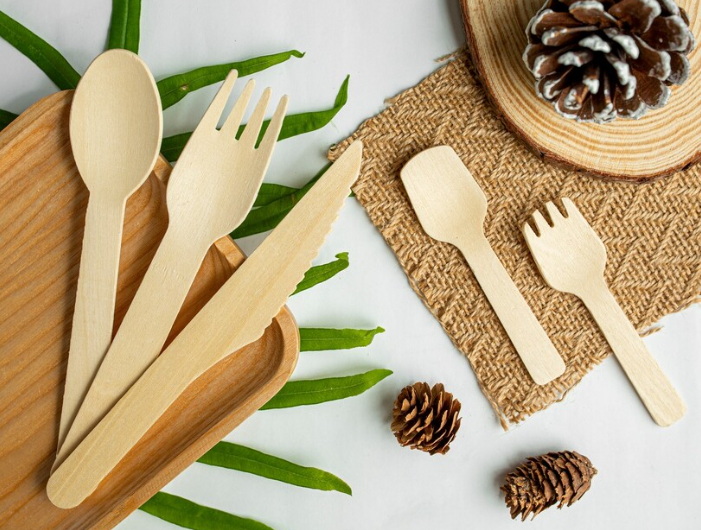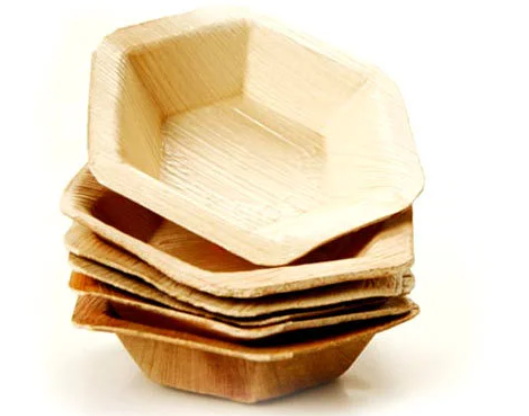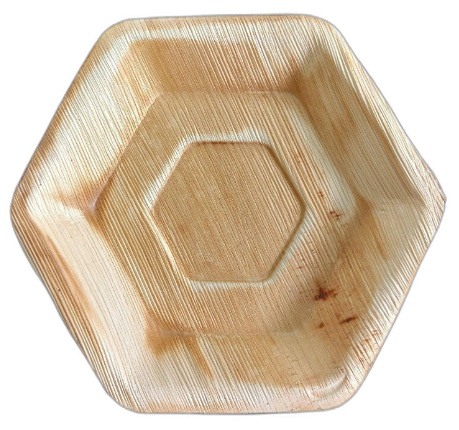
Content Menu
● Introduction to Wood Hexagon Disposable Plates
>> Advantages of Wood Hexagon Disposable Plates
● Manufacturing Process of Wood Hexagon Disposable Plates
>> 1. Material Selection and Preparation
>> 2. Cutting and Shaping
>> 3. Sanding and Smoothing
>> 4. Finishing and Treatment
>> 5. Quality Control and Packaging
● Environmental Impact of Wood Hexagon Disposable Plates
● Market Trends and Demand
>> Benefits of Eco-Friendly Disposable Plates
● Use Cases for Wood Hexagon Disposable Plates
● Comparison with Other Eco-Friendly Options
● Technological Advancements in Eco-Friendly Plates
● Consumer Preferences and Market Growth
● Conclusion
● FAQ
>> 1. What are the primary materials used to make wood hexagon disposable plates?
>> 2. How are wood hexagon disposable plates more eco-friendly than traditional disposable plates?
>> 3. What is the typical shape and size of wood hexagon disposable plates?
>> 4. Can wood hexagon disposable plates be reused?
>> 5. Are wood hexagon disposable plates safe for microwave use?
● Citations:
The production of wood hexagon disposable plates involves a combination of traditional woodworking techniques and modern manufacturing processes. These plates are not only visually appealing due to their hexagonal shape but also offer an eco-friendly alternative to traditional disposable plates made from plastic or paper. In this article, we will delve into the step-by-step process of creating these innovative plates.

Introduction to Wood Hexagon Disposable Plates
Wood hexagon disposable plates are crafted from natural wood materials, often sourced from sustainable forests. The use of wood as a primary material provides these plates with a unique aesthetic and environmental benefits. Unlike paper or plastic plates, wood plates can be composted at the end of their life cycle, reducing waste and supporting a more circular economy.
Advantages of Wood Hexagon Disposable Plates
- Eco-Friendly: Made from natural wood, these plates are biodegradable and compostable.
- Unique Design: The hexagonal shape adds a modern and stylish touch to any table setting.
- Durability: Wood plates are more robust than paper plates and can withstand heavier loads.
Manufacturing Process of Wood Hexagon Disposable Plates
The manufacturing process of wood hexagon disposable plates involves several key stages:
1. Material Selection and Preparation
The first step is selecting the appropriate wood material. Typically, thin slices of wood are used, often from birch or bamboo, due to their durability and sustainability. The wood is cleaned and prepared to ensure it is free from any debris or imperfections.
2. Cutting and Shaping
The prepared wood slices are then cut into hexagonal shapes using specialized cutting tools or machines. This process ensures uniformity in size and shape across all plates.
3. Sanding and Smoothing
Each hexagonal piece is sanded to smooth out any rough edges or surfaces. This step is crucial for ensuring the plates are safe to use and aesthetically pleasing.
4. Finishing and Treatment
To enhance durability and resistance to moisture, the plates may undergo additional treatments such as applying a food-safe oil or wax coating.
5. Quality Control and Packaging
Finally, the plates are inspected for quality and packaged for distribution. This includes ensuring they are clean, dry, and ready for use.

Environmental Impact of Wood Hexagon Disposable Plates
The use of wood hexagon disposable plates contributes positively to environmental sustainability by reducing reliance on non-biodegradable materials like plastic. However, it's essential to ensure that the wood is sourced responsibly to avoid deforestation. The biodegradable nature of these plates means they can be composted, reducing waste and supporting a circular economy.
Market Trends and Demand
The demand for eco-friendly disposable plates, including those made from wood, is on the rise. This trend is driven by growing sustainability awareness and regulatory bans on single-use plastics in many regions. The global disposable plates market is projected to expand significantly, with a focus on biodegradable and compostable materials like wood fiber, bamboo, and sugarcane pulp[3].
Benefits of Eco-Friendly Disposable Plates
- Reduced Plastic Waste: By choosing eco-friendly options, consumers can significantly reduce plastic waste.
- Compostability: These plates can be composted, reducing landfill waste and supporting sustainable waste management.
- Sustainability: Made from renewable resources, these plates align with global efforts to promote sustainability.
Use Cases for Wood Hexagon Disposable Plates
Wood hexagon disposable plates are versatile and can be used in various settings:
- Restaurants and Cafes: They offer a unique and eco-friendly dining experience, enhancing the aesthetic appeal of meals.
- Outdoor Events: Perfect for picnics, barbecues, and festivals, these plates add a natural touch to outdoor gatherings.
- Formal Gatherings: Their distinctive design makes them suitable for formal events, providing a stylish alternative to traditional disposable plates.
Comparison with Other Eco-Friendly Options
While wood hexagon disposable plates are a popular choice, other eco-friendly options like bamboo plates and bagasse plates also offer sustainable alternatives. Bamboo plates are known for their durability and natural charm, while bagasse plates are made from sugarcane fibers, offering a compostable solution[4].
Technological Advancements in Eco-Friendly Plates
Technological advancements are playing a crucial role in enhancing the durability and functionality of eco-friendly disposable plates. Improved manufacturing techniques and water-resistant coatings are making these plates more practical for everyday use[3].
Consumer Preferences and Market Growth
As consumers increasingly prioritize sustainability, the demand for eco-friendly disposable plates is driving market growth. This shift towards sustainable products is expected to continue, with companies innovating to meet consumer expectations for greener solutions[3].
Conclusion
Wood hexagon disposable plates offer a unique blend of style, durability, and environmental responsibility. By understanding the manufacturing process and benefits of these plates, consumers can make informed choices about their tableware, supporting sustainable practices while enhancing their dining experiences.

FAQ
1. What are the primary materials used to make wood hexagon disposable plates?
The primary materials used are thin slices of wood, often sourced from sustainable forests, such as birch or bamboo.
2. How are wood hexagon disposable plates more eco-friendly than traditional disposable plates?
They are biodegradable and compostable, reducing waste and supporting a circular economy.
3. What is the typical shape and size of wood hexagon disposable plates?
These plates are hexagonal in shape and can vary in size, but they are often designed to be compact and visually appealing.
4. Can wood hexagon disposable plates be reused?
While they are durable, they are designed as disposable plates. However, some may be reused if properly cleaned and maintained.
5. Are wood hexagon disposable plates safe for microwave use?
No, they are not recommended for microwave use due to the risk of wood igniting or becoming damaged.
Citations:
[1] https://www.biologischverpacken.de/en/assortment/compostable-tableware/wood-fibre/plate/
[2] https://www.anchengfoodservice.com/what-are-advantages-of-disposable-wooden-plates.html
[3] https://www.accessnewswire.com/newsroom/en/industrial-and-manufacturing/disposable-plates-market-to-expand-at-36-cagr-through-2035-driven-by-fo-983798
[4] https://www.efavormart.com/collections/eco-friendly-paper-plates
[5] https://www.linkedin.com/pulse/wooden-made-plates-spoons-benefits-you-need-know-mohammed-ansaf-ansaf
[6] https://www.youtube.com/watch?v=ikd-kOsfCEk
[7] https://www.alibaba.com/showroom/disposable-plate-hexagon.html
[8] https://academy.monouso-direct.com/types-of-plates/
[9] https://www.alibaba.com/showroom/hexagonal-bamboo-plate.html
[10] https://www.tairchu.com.tw/en/category/A0506.html
[11] https://www.ecoplates.com.au/product/hexagon-ecoplates/
[12] https://www.pappcoindia.com/products/party-centric-10-inch-wooden-hexagonal-plate-pack-of-50
[13] https://www.marketresearchfuture.com/reports/disposable-paper-plates-market-38511
[14] https://greenhome.en.made-in-china.com/product/VnZrLekvbuWf/China-Disposable-Biodegradable-Paper-Container-Food-Grade-Hexagon-Paper-Plate-Customizable-Logo-Color-for-Dinner.html
[15] https://www.talkingtables.co.uk/products/we-heart-pastels-large-hexagonal-plates-6-colours-26cm-12pk
[16] https://www.tradeindia.com/products/environment-friendly-recyclable-hexagonal-areca-leaf-plate-7810024.html
[17] https://www.packnwood.de/en/blog/55_top-10-best-selling-premium-disposable-plates-on-the-internet.html
[18] https://diyecobox.com/how-are-paper-plates-made-a-simple-guide/
[19] https://www.youtube.com/watch?v=srI7g8nSzVM
[20] https://www.verifiedmarketresearch.com/product/hexagon-shaped-tables-market

















